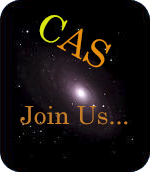Klaus
Yes
The following article is published here with permission of the Royal Astronomical Society of Canada.
( April / avril 2016 JRASC | Promoting Astronomy in Canada )
A Brief History of Lunar Exploration: Part II
by Klaus Brasch
"We choose to go to the moon in this decade and do the other things, not because they are easy, but because they are hard.”
— John F. Kennedy, 1962 September 12
Introduction
The first part of this concise history of lunar exploration spans the pre-telescopic era to the early 19th century and the beginnings of scientific selenography (Brasch, 2015). It’s important to appreciate that lunar observing, as well as most other facets of observational astronomy, was done primarily by amateurs at that time; often brilliant individuals, some of independent means, who literally dabbled in what was widely termed Natural Philosophy or philosophia naturalis. Some, like Cassini, Huygens, and the Herschels, had royalty or wealthy patrons for support, much like most musicians and artists at the time, and were in fact closest to what we consider professional practitioners today. The concept of Natural Science, based on observational, experimental, and verifiable evidence, emerged only gradually during the late 18th and early 19th centuries. By then, science had been formally subdivided into the life and physical branches and was practiced primarily at universities and other professional institutions (en.wikipedia, 2015a).
Selenology Matures
Thanks to Johann Schrőter’s broad impact on so many aspects of observational astronomy, particularly in continental Europe, coupled with what was likely the 18th-century prime example of “aperture fever,” he no doubt inspired many of his contemporaries to take up the baton. Although much criticism has since been levelled against Schrőter, mainly for some of his strange claims and ideas about changes on the Moon and that our satellite might be inhabited by intelligent beings, as we saw above, he was not alone in those regards. As Patrick Moore attests (Moore, 1963, p.57):
“The mantle of Schrőter fell upon three of his countrymen, Lohrmann, Beer and Mädler. All were clever draughtsmen as well as being good observers, and between them they explored every square mile of the Moon’s visible surface—but it must be remembered that they had Schrőter’s work to use as basis. The credit for founding the science of precise lunar observation must go to the Lilienthal amateur, and to him alone.”
A professional surveyor and cartographer, Wilhelm Gotthelf Lohrmann (1796–1840) (Figure 1) brought those skills to selenography as well as a superb 4.8″ Fraunhofer achromatic refractor to generate the best and most accurate lunar charts up to that time (Figure 1). His resultant 1878 book titled Topographie der sichtbaren Mondoberfläche (Topography of the visible lunar surface), contained accurate descriptions of the methods used and results obtained, and can be regarded as the first modern dissertation on selenography (Kopal and Carder, 1974, p.29). Although Lohrmann had intended to produce a true topographic map using micrometric readings of some 79 selected surface features, he was plagued by poor health and sadly could not finish his planned large Moon map, which was not published until 1878, 38 years after his death by Johann Schmidt (1825–1884). Unlike Gruithuisen before him, Lohrmann was cautious and not subject to over-interpretation of what he saw. With regard to Gruithuisen, speculations that Wallwerk, in the Sinus Aestuum series of lunar rilles, might be the work of intelligent beings, Lohrmann stated “One must with great circumspection, under every condition of lighting, attend to this region if one hopes to depict it accurately” (Sheehan and Dobbins, 2001, p. 97).
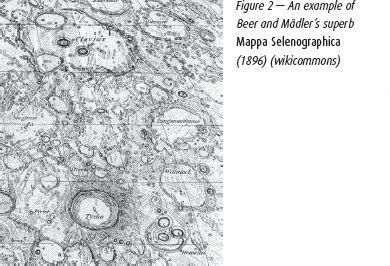
Undoubtedly the title of most prominent 19th-century lunar cartographers rightfully belongs to the duo of Wilhelm Beer (1797–1850) and Johann Heinrich von Mädler (1794–1874) (Figure 1). Mädler, an excellent young student who enrolled at age 12 in the Friedrich-Werdersche Gymnasium in Berlin, was set on an academic career, but after a typhus outbreak claimed both his parents, he was left responsible for four younger siblings (Sheehan and Dobbins, 2001, p. 101). While studying to become an elementary school teacher to make a living, he also attended lectures at the University of Berlin. Beer, a wealthy Berlin banker, with the means and the interest to establish a private observatory in 1829, hired Mädler to tutor him in astronomy and work for him. Thus began a long and fruitful collaboration. Equipped with a 95-millimetre Fraunhofer refractor, both men were fully committed to mapping the Moon, although the science- and mathematicseducated Mädler was responsible for most of the actual observing and cartographic work. They set out to produce the first exacting lunar map and spent 600 nights carefully laying out a grid of surface reference points and measuring them micrometrically. The finished product (Figure 2) appeared in 1836 as Mappa Selenographica, an atlas fully one metre in diameter, which included 140 new feature names beyond those assigned by Hevelius, Riccioli, and Schrőter (Hockey, 1986). In 1837, Der Mond, a detailed description of the entire lunar surface was published, and both works remained unsurpassed in wealth of information for several decades (Kopal and Carder, 1974).
In addition to lunar work, Beer and Mädler also made detailed observations of Mars, making quite accurate determinations of its rotation period and selecting what is now known as Sinus Meridianis as the planet’s prime meridian. In 1836, Mädler was appointed observer at the Berlin Observatory under Johann Encke, and in 1840 became director of Dorpat Observatory in Tartu, Estonia, home of the Great Fraunhofer refractor where he studied the planets, double stars, and the proper motions of stars (en.wikipedia, 2015c).
A staunch critic of Schrőter and his methodology, as well as Herschel and Gruithuisen’s assumptions that our satellite was in any way similar to the Earth, Mädler maintained that the Moon was essentially airless, lacked any evidence of water and was most likely changeless (Moore, 1963). Thus, despite some erroneous conclusion of his own, including that the phases of the Moon and sunspots might influence our weather and that the centre of the galaxy was in the direction of the Pleiades, Mädler was one of the 19th-century’s most eminent astronomers, as acknowledged by craters on both the Moon and Mars named in his honour. Beer, too, was honoured by a small lunar crater bearing his name.
With Beer and Mädler’s seemingly definitive map of the Moon, coupled with the daunting realization that our satellite was probably a dead, airless, and lifeless desert, selenography went into temporary eclipse and was no longer considered fashionable astronomical work. As pointed out by Sheehan and Dobbins (2001) in a chapter entitled Depression and Paralysis, the latter half of the 19th century was a period of great change in both theoretical and observational science. Advances were being made on many fronts: astronomy, biology, and geology, and it was becoming increasingly difficult to rationalize biblically derived timelines for the origins and evolution of the Solar System, the Earth, and life itself.
The Rise of Evolutionary Thinking
Beginning with the Solar System, the first rational attempts at explaining its origin began in 1644 with French philosopher René Descartes’s (1506–1650) (Figure 3) proposal that the Sun and planets formed through a force of vortices thought to permeate the Universe. As this idea preceded Isaac Newton, the laws of gravity were not widely understood. Almost a century later, in 1734, Swedish theologian and scientist, Emanuel Swedenborg proposed the so-called Nebular Hypothesis. This hypothesis was further developed in 1755 by the great German philosopher, Immanuel Kant (1724–1804) (Figure 3), wherein gaseous clouds or nebulae slowly rotate and collapse under gravity, eventually forming stars and planets.


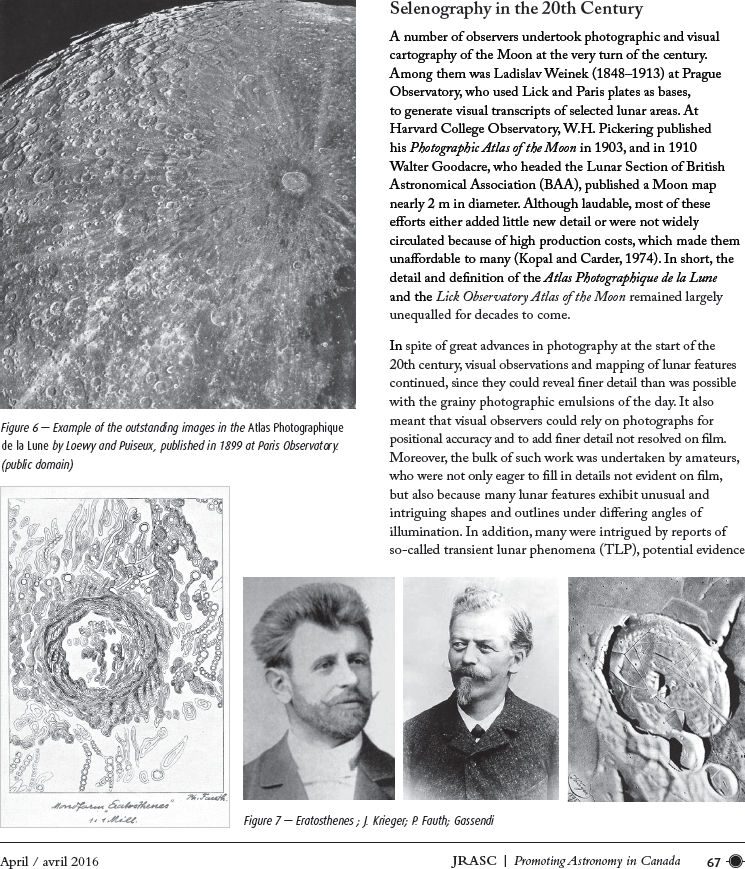

of latent volcanism, impacts by asteroids and meteors, or simply venting of subsurface volatiles, efforts that continue to this day, (see below: Does Anything Ever Happen on the Moon?) and e.g. (Haas, 1942; Wood, 2012; O’Connell and Cook, 2013).
Among leading early 20th-century selenographers were two German observers, Johann Krieger(1865–1902) and Philipp Fauth (1867–1941). Krieger (Figure 7) was a gifted visual observer and draftsman determined to produce a definitive map of the Moon. Using a fine 270-millimetre refractor and some of the best high-resolution lunar photographs from Paris and Lick Observatories as base, he would add fine visual detail with ink and graphite, resulting in some splendid and very artistic depictions of major craters and other features (Kopal and Carder, 1974). Sadly, due to frailty and failing health, he never finished his stated goal, but 28 of his finest images were later published as a Mond-Atlas in 1912. Like Kreiger, Fauth was also a gifted and meticulous draftsman who used photographs as a basis for adding details detected visually (Figure 7). He too intended to produce a definitive map of the Moon to a scale of 1:1,000,000, larger than any up to that point in time. In part because of Fauth’s abrasive nature, his adherence to the bizarre theory advanced by Hanns Hörbiger of “glacial cosmogony,” the rise of Nazi Germany and World War II, his dream of a lunar map never materialized. The map was finally finished; however, in 1964 by his son Hermann (Sheehan and Dobbins, 2001).
Among the most productive and successful mid-20th-century observational selenographers were British amateurs H.P. Wilkins (1896–1960) and Sir Patrick Moore (1923–2012) (en.wikipedia (2015d). Wilkins produced a 300-inch map of the Moon in 1951 (Figure 8) and a joint work with Moore in 1955, The Moon; A Complete Description of the Surface of the Moon: containing the 300-inch Wilkins Map (Wilkins and Moore, 1955). Though revised in 1961, the work was criticized for its cluttered and frequently erroneous depiction of several lunar features (Kopal and Carder, 1974, Wikipedia (2015h). By that time as well, advances in lunar photography and publication in 1960 by Kuiper et al., of the Photographic Lunar Atlas (Kuiper, et al, 1960), rendered it largely obsolete.
The Photographic Lunar Atlas, a milestone in pre-space age efforts at lunar mapping, was initiated by renowned Dutch-American astronomer Gerard P. Kuiper (Figure 9), also of Kuiper Belt fame, among many other honours. The atlas was based on enlargements of the best available photographs from Lick, Mt. Wilson, McDonald, Pic du Midi, and Yerkes observatories; and combined the work of numerous astronomers. It contained some 281 illustrations, many under different conditions of illumination and on a scale of 1:370,000. This atlas was subsequently overlaid with accurate lunar co-ordinates (Figure 9) and published as the Orthographic Atlas of the Moon (Arthur and Whitaker (1962), and later as the Rectified Lunar Atlas (Whitaker et al. 1963) projected unto a sphere (Figure 9). Among many other revelations, this technique pioneered by Kuiper’s student, William K. Hartmann (Figure 9) provided the first unequivocal evidence of the huge lunar impact basin, Mare Orientale. With arrival of the space age, therefore, professional interests in lunar cartography and geology were rekindled.
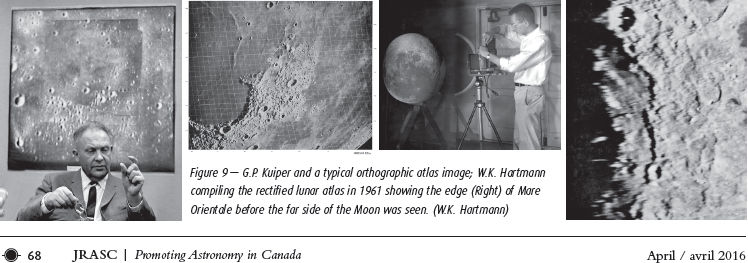
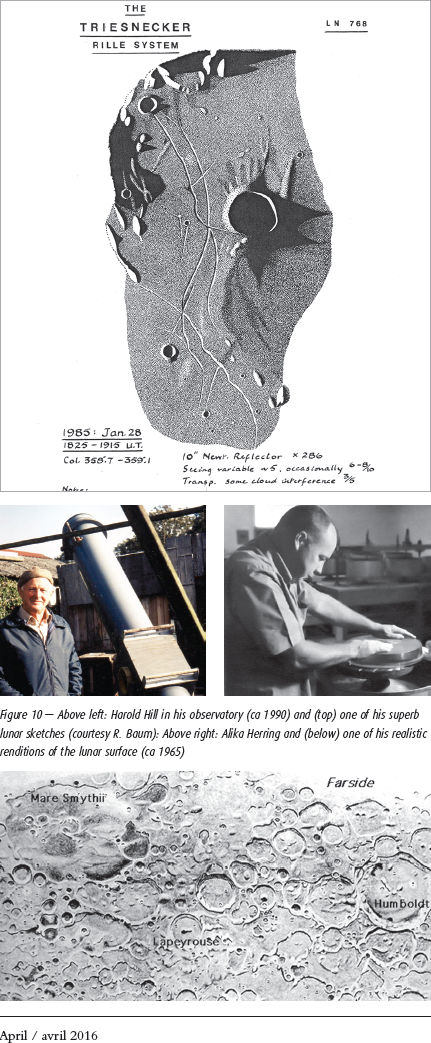
At least two other noteworthy 20th-century visual lunar cartographers were British amateur Harold Hill (1920–2005) and American Alika K. Herring (1913–1997). While relatively unknown today (Strach and Baum (2006)), Hill combined great artistry with photographic accuracy in his cartographic work (Figure 10), culminating in his Portfolio of Lunar Drawings (Hill, 1991). A meticulous observer, he developed a unique, stipplingenhanced drawing style, that elegantly combined accuracy and artistry.
Talented telescope-maker for the renowned firm of Cave Optical in California, Alika Herring was an exceptional amateur lunar observer and a prominent member of the association of Lunar and Planetary Observers (Figure 10). His compelling lunar drawings graced many issues of Sky & Telescope magazine in the 1950s and ‘60s, and, because he was so good at his craft, he was hired in 1960 by the recently founded Lunar and Planetary Laboratory in Tucson, Arizona, to help produce charts for the newly announced Apollo mission.
In the half-century or so before the space program, studies of the Moon and planets were largely abandoned by professional astronomers in favour of galactic astronomy and astrophysics. Although amateurs partially filled that vacuum, and a handful of professional observatories, notably Lowell, Pic du Midi, and Yerkes, maintained lunar and planetary programs, huge knowledge gaps remained (Brasch, 2016). All that changed, however, with the advent of the space program. In addition to establishment of the Lunar and Planetary Lab, the recently formed National Aeronautics and Space Administration (NASA) and U.S. Air Force funded the International Planetary Patrol Program at Lowell Observatory, the USAF Aeronautical Chart and Information Center (ACIC), and US Army Map Services (AMS) funded a massive effort to produce a series of high-resolution Lunar Aeronautical Charts (LAC) (Kopal and Carder, 1974; The Moon (2011)).
Initiated in 1959, the LAC effort was headed by ACIC cartographer Howard Holmes, and the Lowell Observatory office was established in 1961. The latter encompassed a team of cartographers, observers, and airbrush specialists, including William Cannell, James Greenacre, Patricia Bridges, Ewen Whitaker, Fred Duncan, Jay Inge, and Edward Barr (Kopal and Carder, 1974). The final Lunar Aeronautical Charts were based on over 12,000 of the best lunar photographs and film images obtained at various institutions, and supplemented by visual observations with the 24-inch Clark refractor (Figure 11). Thanks to these visual additions, many of the charts included surface detail as small as 200 metres (St. Clair et al., 1979).
Does Anything Ever Happen on the Moon?
In 1942, a young American amateur astronomer, Walter Haas (1917-2015), the future founder of the Association of Lunar and Planetary Observers (ALPO), pondered the foregoing question in an extensive review article (Haas, 1942). He was not the first student of our Moon to pose this question, of course, but did it at a time when reports of extensive, visible changes on the lunar surface were relatively frequent.
I well recall as a newly minted teenage astronomy enthusiast joining the Montreal Centre of the RASC in 1958, and being immediately contacted by Geoffrey Gaherty, who asked me if I wanted to join the Centre’s Lunar Meteor Section. Despite having absolutely no idea what that was, I agreed, and Geoff and I remain friends to this day. The idea at the time was that, since the Moon is most likely bombarded by meteors just like the Earth, perhaps it was possible to spot such events by examining the very new and old Moon telescopically when its bright crescent is thin and earthshine most prominent. Moreover, only multiple observers seeing such an event simultaneously would have any credence. We were fully aware even then, that our satellite had no measurable atmosphere and only a truly major meteoric event might be spotted from Earth with small telescopes. Still we persisted for several years, often under frigid winters and mosquito-ridden Montreal summers, ultimately to no avail of course.
Our enthusiasm for such transient lunar phenomena (TLPs) or lunar transient phenomena (LTPs), was fueled by a sensational 1958 November 2 report by Russian astronomer, Nikolai Kozyrev, that he had observed an apparent eruption on the central peak of the prominent crater Alphonsus (en. wikipedia, 2015e; Wood, 2012). Using a 122-centimetre reflector, he also obtained spectra during the half-hour event, and reported a marked brightening of the central peak. He also claimed observing bright gaseous emission lines in the spectra due to C2 and C3 molecules. Although largely discredited since, this report nonetheless drew renewed attention to the possibility that things might indeed happen on the Moon.
A far more credible TLP report followed a few years later on 1963 October 19 (O’Connell and Cook, 2013). James Greenacre and Edward Barr, two of the AICI cartographers observing with the 24″ refractor at Lowell Observatory, reported distinct red colouration inside the crater Aristarchus and along Schrőter’s Valley. Although this event has been attributed by some to atmospheric dispersion and probably accentuated in an achromatic refractor (Sheehan and Dobbins, 2001), it did arouse major new interest in TLPs. Sporadic TLP reports by several professional and amateur astronomers followed, and seem to fall into the following classes: outgassing, impact events, electrostatic phenomena, and illusory factors caused by bad seeing conditions and atmospheric effects (en.wikipedia, 2015e, Wood, 2012). Clearly what is needed at this point to tackle this issue are systematic and coordinated observing programs, using not just visual methods but also now commonly available webcam and CCD technologies. Fortunately, organizations like the Association of Lunar and Planetary Observers and the British Astronomical Association are doing just that.
April / avril 2016 JRASC | Promoting Astronomy in Canada
Note:The author is grateful to Richard Baum and William K. Hartmann for providing photographs, images, and special insight for this article.
Klaus Brasch is a retired bio-scientist and a public program volunteer at Lowell Observatory. He fi rst joined the RASC in 1957 and has been an avid amateur astronomer ever since. A frequent contributor to JRASC, SkyNews and Sky & Telescope, he enjoys astrophotography from his observatory in Flagstaff , Arizona.
References
- Arthur, D.W.G. and Whitaker, E.A. (1962) Orthographic Atlas of the Moon-Supplement Number One to the Photographic Lunar Atlas.
- iBaum, R. (2010) Harold Hill and the South Polar Region of the Moon. J. Br. Astron. Assoc. 120, 2, 86-97.
- Brasch, K. (2015) A Brief History of Lunar Exploration: Part I, JRASC 109, 251-260.
- Brasch, K. (2016) Th e Dawn of Global Planet Watches, Sky & Telescope, 131, 3, 52-54.
- en.wikipedia (2015a) https://en.wikipedia.org/wiki/Natural_science
- en.wikipedia (2015b) http://en.wikipedia.org/wiki/Nebular_hypothesis
- en.wikipedia.org/wiki/Johann_Heinrich_von_Mädler
- en.wikipedia (2015d) https://en.wikipedia.org/wiki/Hugh_Percy_Wilkins
- en.wikipedia (2015e) http://en.wikipedia.org/wiki/Transient-lunar phenomenon
- Fisher, C. (1943) Th e Story of the Moon, Th e American Museum of Natural History Series, Doubleday, Doran and Company, Inc., Garden City, NY, USA.
- Ford, W. (2013) http://wayneford.tumblr.com/post/45762409460/atlas-photographique-de-la-lune-loewy-and
- Haas, W. (1942) Does anything ever happen on the Moon? JRASC 36, 237-272.
- Hill, H. (1991) A Portfolio of Lunar Drawings, Cambridge University Press, Cambridge, UK.
- Hughes, S. (2013) Catchers of the Light: A History of Astrophotography www.catchersofthelight.com/
- Kopal, Z. and Crader, R.W. (1974) Mapping of the Moon, Past and Present, R. Reidel Publishing Company, Dordrecht, Holland.
- Kuiper, G.P., Arthur, D.W.G., Moore, E., Tapscott, J.W., and Whitaker, E.A. (1960) Photographic Lunar Atlas Based on Photographs Taken at the Mount Wilson, Lick, Pic du Midi, McDonald and Yerkes Observatories.
- Moore, P. (1963) Survey of the Moon, Eyre & Spottiswoode, Ltd., London, UK.
- O’Connell, R. and Cook, A. (2013) Revisiting the 1963 ‘Aristarchus events,’ J. Brit. Astron. Assoc. 123, 4, 197-208.
- Ré, P. (2014) First Lunar Maps http://astrosurf.com/re
- Sheehan, W. and Baum, R. (1995) Observation and inference: Johann Hieronimous Schroeter, 1745–1816, J. Brit. Astron. Assoc. 105, 4, 171-175.
- Sheehan, W. and Brasch, K. (2013) Th e “Loch Ness” of Venus, SkyNews, 19, 36-37.
- Sheehan, W.P. and Dobbins, T.A. (2001) Epic Moon, Willmann-Bell, Inc., Richmond, VA.
- Strach, E.H. and Baum, R.M. (2006) Harold Hill (1920–2005) J. Br. Astron. Assoc. 116, 4, 203–204.
- St. Clair, J.H., Carder, R.W., and Schimmerman, L.A. (1979) United States lunar mapping - A basis for and result of project Apollo. Moon and Planets, vol. 20, Apr. 1979, p. 127-148.
- Tarbuck, E.J. & Lutgens, F.K. (2011) Earth: an introduction to physical geology, Prentice Hall, New Jersey, USA.
- The Moon (2011) https://the-moon.wikispaces.com/History+of+the+LAC+maps
- Whitaker, E.A., Kuiper, G.P., Hartmann, W.K., and Spradley, L.H. (1963) Rectifi ed Lunar Atlas, University of Arizona Press, Tucson, AZ.
- Whitaker, E.A. (1989) Selenography in the seventeenth century, chapter 8 in: Th e General History of Astronomy, vol. 2, Planetary astronomy from the Renaissance to the rise of astrophysics, René Taton and Curtis Wilson eds., Cambridge University Press, UK.
- Williams, M. (2010) www.universetoday.com/77525/nebular-theory/
- Wood, C.A. (2012) Transient lunar phenomena and the modern understanding of the Moon in: Th e Moon, Vol. 2, 36–42, BAA Lunar Section.
Outreach || Flagstaff || Photos || Articles || Observing Sites || Weather
Coordinated Universal Time || National Weather Service
info@coconinoastro.org

